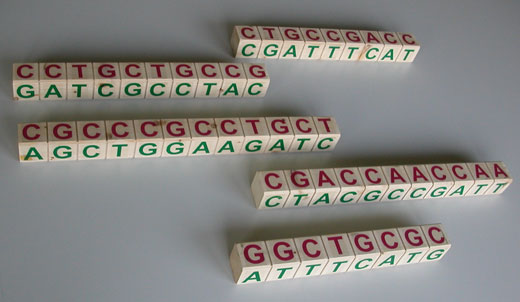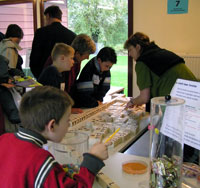Fun with genomes: the Mycomuncher DNA Puzzle Teach article
Fed up with explaining genomes, genes and proteins? Why not get your students to figure it out for themselves using Johan Leveau’s DNA puzzle?
Looking for a fun, hands-on teaching tool to explain genomes, genes and proteins? The Mycomuncher DNA Puzzle may be just what you’re looking for. Like a real scientist, experience the thrill of genome research. Get an appreciation for the work that goes into breaking the DNA code. And learn how DNA carries the information for all kinds of biological functions. Suitable for educating students at the primary- and secondary-school level, the Mycomuncher DNA Puzzle can also be used as supporting material for general-audience science fairs and for university courses in biology and ecology. Ten minutes is all a basic game of DNA puzzling takes.
Meet the mycomuncher
Based on ongoing research at the Netherlands Institute of Ecology (NIOO-KNAW)w1, the Mycomuncher DNA Puzzle features Collimonas fungivorans,a newly discovered soil bacterium that has the unique ability to eat fungi (moulds). Hence its nickname: the mycomuncher, from the Greek word mycos meaning fungus. Researchers at the NIOO-KNAW and elsewhere are very excited about this bacterium, because it may hold new clues to treating or preventing fungal diseases in humans, plants, or other organisms. To discover what makes Collimonas a mycomuncher, we are currently analysing the total DNA, or genome, of this bacterium. Using the Collimonas project as an example, the Mycomuncher DNA Puzzle explains what a genome is, what it is good for, and how genomic DNA can be read and understood in relation to the biology of the organism it belongs to. In other words, how do we go from long sequences of only four different DNA letters (A, C, G, and T) to a property such as ‘eating fungus’?
Here’s the challenge
The objective of the Mycomuncher DNA Puzzle is to complete several tasks representing the sequential steps in a typical genome project, from DNA assembly to the formulation of hypotheses.

Image courtesy of Johan Leveau
The first challenge is to assemble five overlapping DNA sequences (represented by five wooden pieces with DNA letters A, C, G and T) into one consensus DNA sequence. This exercise shows that a genome cannot be read in one go, but needs to be determined from smaller fragments, which then have to be assembled, much like a puzzle, to obtain a full-length sequence.

Image courtesy of Johan Leveau
The next task is to translate the consensus DNA sequence, representing a typical Collimonas gene, into protein. This is achieved by lining up three-letter DNA sequences (codons) that are linked to a particular amino acid (see image to the left). Amino acids are the building blocks of proteins. This part of the Mycomuncher DNA Puzzle illustrates the role of DNA as a carrier of information and how this information is translated into proteins.

Image courtesy of Johan Leveau
The third challenge is to find out how Collimonas might use this protein to eat fungus. The lesson of this task is that not much can be learned from a protein sequence per se. Instead, players are invited to compare their newly identified protein with a list of proteins from other organisms, the functions of which have already been studied by other researchers.
One of the listed proteins will match the one that the players identified for Collimonas. Players are challenged to think about how its function might be involved in mycomunching. An example is the protein chitinase which breaks down chitin, a structural component of the fungal cell wall. One could hypothesise that Collimonas uses this protein to degrade the cell wall to access nutrients which are contained within the fungus. To assist in the formulation of hypotheses, the puzzle includes a scale model of the interaction between Collimonas and a fungus. Hypotheses from different groups of students can be written on the blackboard, compared and discussed.
Teaching team work and other scientific principles
Besides educating its players on genes and proteins, the Mycomuncher DNA Puzzle stimulates team effort when played in groups. The four sides of the wooden DNA blocks allow four different DNA assemblies: thus, one game actually represents four puzzles in one, with four different proteins and four opportunities to think about how they fit into the mycomunching lifestyle of Collimonas.
Typically, it takes no more than 10 minutes to complete one game, although more time can be spent on each of the steps, for example to discuss or provide background information. The puzzle also exposes students to some basic principles of scientific research. These include the formulation of hypotheses and sharing results with fellow scientists (for example, had others not made public their research findings, how would it have been possible for us to assign a possible function to our Collimonas protein?).
For advanced students, the basic concepts of the puzzle can be combined with the use of Internet-based programmes on classroom computers to show what it means to assemble and decode not just five short pieces of DNA, but hundreds of thousands, as is the case in a real genome project. The teacher’s manual that comes with the puzzle provides several examples. The puzzle can also be used to explain other DNA-related issues, such as the effect of changes (mutations) in the DNA on the amino-acid sequence and function of proteins.
Coming soon…
Real genes!
The Mycomuncher DNA Puzzle uses real DNA sequence data, derived from the genome of Collimonas fungivorans. Each puzzle includes a certificate with a unique link to one of the genes in the Collimonas genome. Students can track this gene on the Collimonas websitew2 to find its location on the Collimonas genome, and learn what protein it codes for, or which laboratories are studying it.
Product information
The Mycomuncher DNA Puzzle is available from the Netherlands Institute of Ecology (NIOO-KNAW): you can either purchase a complete set or request (free) instructions for building the puzzle yourself. For details, please visit the Collimonas websitew2, or email c.fungivorans@nioo.knaw.nl
One standard set of the basic game consists of five wooden pieces of DNA sequences for assembly, one wooden piece with four consensus DNA sequences and one with four corresponding protein sequences, 30 wooden pieces representing codons with their matching amino acid, six A3-sized posters with wooden stands, one scale model of the Collimonas-fungus interaction, and a teacher’s manual.
A teacher’s experience of the Mycomuncher DNA Puzzle
Mai-Britt Meijer, a biology teacher from the Netherlands, tested the Mycomuncher DNA Puzzle with her students.
As a teacher, I always welcome new methods and new ways of teaching. The Mycomuncher DNA Puzzle is an original and stimulating teaching tool because it enables students to ‘let go’ of the textbook and investigate the steps of protein synthesis. Not only are the students physically occupied, but also they are forced to think about the formulation of hypotheses and the scientific method of determining gene functions.

Puzzle in action. This
photograph was taken at the
2004 science fair at the
Netherlands Institute of
Ecology (NIOO-KNAW),
showing junior wannabe
genome researchers solving
the mycomuncher challenge
Image courtesy of Johan Leveau
Before playing the puzzle, I discussed the theory of protein synthesis with the class. The knowledge of the students (pre-university education, ages 15-16) was quite high, which is a necessity.
After a short introduction to Collimonas fungivorans, the class was divided into groups of three to four students. Those who were not busy with the puzzle worked independently on an assignment related to DNA and proteins.
The class worked together to find the first DNA sequence consensus and to understand how the puzzle worked. Next, one group at a time searched for their own consensus sequence (one of four). As each group found its consensus sequence, it moved onto the next step (identifying the corresponding codons). The groups could work without any guidance since the posters clearly explained each step.
When all groups reached the last step (suggesting the function of the protein encoded by their consensus sequence), we discussed their hypotheses as a group: what did they think were the functions of their encoded proteins? The exercise can raise significant questions such as: How do the students form their hypotheses? Are the hypotheses formulated correctly? What kind of experiments can they think of to test their hypotheses? Especially for the more advanced students, this exercise can prove to be very helpful in training them to give elaborate though precise answers.
The students suggested, and I agree, that the puzzle would be more complete if it included additional steps of transcription from DNA to messenger RNA and translation to amino acids. This extension, which will be available in future, will allow the puzzle to be used as an introduction to DNA transcription and protein translation. It will give the students a physical reminder of all the steps involved in this kind of research and the steps of the puzzle can be referred to when discussing the theory in subsequent lessons.
It was nice to see the students playing around with the wooden blocks. Their initial reaction when seeing the wooden pieces was that they were back in nursery school. When starting with the puzzle, however, they soon realised that it is not as easy as it appears, but that it takes a lot of work to decipher the DNA code and the function of genes.
Even though there are a lot of tools available on the Internet, the Mycomuncher DNA Puzzle has the advantage of enabling students to work with their hands. It is especially useful because they are able to really visualise what they are doing. As a final remark, it’s worth noticing that the students have to work together, and discuss issues to be able to complete all the steps of the puzzle. This is, once again, a great advantage.
Web References
- w1 – For more information on the Netherlands Institute of Ecology (NIOO-KNAW), visit www.nioo.knaw.nl
- w2 – Collimonas website
Review
This article describes didactical material aimed at school level and developed within a research institute. This is quite a novelty for teachers, who often see a gap between academic research and science teaching at school.
The idea is simple but ingenious: to transform scientific data about a bacterial genome and its ecology into a game to be played in the classroom and completed on the Internet, thus combining hands-on and e-learning methodologies to address the basic biological topics of DNA, gene expression and metabolism.
I recommend this article to secondary-school teachers interested in innovative didactical tools: they will find structured material ready-to-use and suitable to make pupils think like scientists. The most skilful teachers will even find instructions for building the game by themselves or together with their students.
Giulia Realdon, Italy





